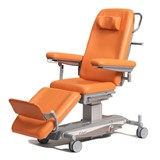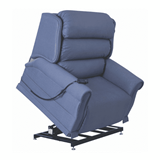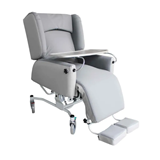Key Features to Consider When Selecting a Podiatry Chair
The right podiatry chair plays a key role in foot and leg care. It helps keep patients comfortable and allows practitioners to work efficiently. With various options on the market, knowing what features to prioritise is essential.
In this article, we’ll cover the top features to look for in a podiatry chair, such as ergonomic design, adjustability, and easy maintenance. Choosing the right chair can significantly improve patient satisfaction and care quality.
1. Comfortable Design
A well-designed ergonomic podiatry chair can create comfort and productivity for patients and clinicians. Adjustable height and positioning are crucial features that allow clinicians to customise the chair for each individual, promoting comfort and reducing fatigue during treatments.
Lumbar support is another crucial factor. A chair with adequate lumbar support can help reduce strain on the lower back, especially during lengthy procedures. This enables practitioners to maintain a neutral spine, minimising discomfort and allowing them to focus on providing excellent care.
Additionally, features that encourage good posture, such as adjustable and contoured backrests, contribute to better alignment. These aspects help prevent long-term musculoskeletal issues and make it easier to reach the treatment area.
2. Adjustable Positioning
Adjustable positioning is a key feature of a podiatry chair. It allows for various adjustments to meet the needs of different treatments and ensure patient comfort. One important adjustment is the reclining backrest, which helps practitioners position patients at the best angle for procedures. This flexibility enhances visibility and access, making it easier to perform tasks accurately.
Leg rests are also essential. Many chairs have adjustable leg rests to accommodate patients of different heights and comfort levels. This is particularly important for procedures that require specific leg positioning, ensuring patients feel secure throughout their treatment.
Additionally, adjusting the chair's height and tilt allows practitioners to customise the chair for each patient, ensuring proper alignment and support. Whether treating children, elderly patients, or those with mobility challenges, a chair that adapts to diverse needs is invaluable.
3. Stability and Weight Capacity
Stability and weight capacity directly affect the selection of a podiatry chair. A sturdy base ensures patient safety during examinations and treatments. A chair that feels stable helps prevent discomfort or accidents for both patients and clinicians. Choosing a chair with solid construction supports various movements without compromising stability.
Weight capacity must align with the needs of the patient population. Most podiatry chairs accommodate a range of weights, typically between 113 kg and 180 kg. Ensuring the chair can safely support their weight while allowing comfortable positioning during treatments is essential for larger patients. A chair designed for higher weight capacity enhances safety and boosts confidence in patients of all sizes.
4. Easy-to-Clean Materials
Given the focus on hygiene in clinical settings, easy-to-clean materials are crucial for podiatry chairs. Upholstery should resist stains and disinfectants used for cleaning. Materials like vinyl and high-quality synthetic fabrics are effective choices, as they can be wiped down easily without losing durability.
Maintaining hygiene in a clinical setting helps prevent the spread of infections and creates a safe environment for patients. Low-maintenance materials save time and effort for practitioners, allowing them to concentrate on patient care rather than cleaning tasks. Selecting a podiatry chair with easy-to-clean materials contributes to a hygienic and efficient patient and clinician experience.
5. Mobility
Mobility influences the effectiveness of a podiatry chair in a clinical setting. Chairs with wheels or casters allow for easy movement, enabling practitioners to reposition the chair quickly. This capability enhances efficiency, especially in busy clinics where swift transitions between treatment areas are essential.
In addition, mobility prevents the chair from rolling or shifting unexpectedly while a patient is being treated, ensuring safety for both patients and clinicians. Selecting a chair with reliable locking features allows
6. Additional Features
A three-section design is beneficial in podiatry chairs, offering height-adjustable mechanisms and reclining head and backrests. This design improves patient comfort and allows practitioners to customise positioning for various treatments, ensuring optimal access during procedures.
Remember that podiatry chairs come in three types: mechanical, pneumatic, or electrically operated. Mechanical chairs are simple and durable, pneumatic chairs allow for smooth height adjustments, and electrically operated chairs provide precise control, making them popular for busy clinics.
It's also useful when a podiatry chair can be transformed into a treatment or massage table, especially when space is limited. This versatility maximises clinical space and accommodates different types of treatments.
A sturdy frame for stability, quality attachments for folding parts, additional head cushions, movable armrests, and independent resting feet. The strong frame ensures long-lasting use, while high-quality attachments enhance safety. These features improve patient comfort and help streamline workflows for practitioners, making the podiatry chair a valuable investment for any clinic.
7. Warranty
When buying a podiatry chair, it's crucial to consider the warranty coverage. A good warranty ensures that the manufacturer will take care of any defects or issues within a specific time frame. This protection safeguards your investment and minimises potential downtime in your practice.
Opting for a podiatry chair from a supplier known for solid warranty coverage and excellent customer service ensures a smoother experience. It contributes to the long-term success of your practice.
Conclusion
The right podiatry chair can make all the difference in foot and leg care. A chair that prioritises comfort and adjustability enhances patient experiences and allows practitioners to work more effectively. Key features to look for include ergonomic design and easy cleaning. Additionally, checking the warranty ensures that the investment is protected. A well-selected chair truly elevates the quality of care provided.
Looking to upgrade your practice?
Get a quote for top-quality podiatry chairs today! Suppliers offer a selection of chairs prioritising comfort, adjustability, and durability, ensuring the best care for your patients. Don’t miss out on this opportunity
FAQ:
-
What features should I look for in a podiatry chair?
Look for ergonomic design, adjustability, lumbar support, easy-to-clean materials, and stability for patient comfort and clinician efficiency.
-
Why is ergonomic design important?
It helps reduce fatigue and discomfort for both patients and practitioners, allowing for longer, more effective treatments.
-
How do adjustable features help?
They let clinicians customise the chair for each patient, ensuring optimal comfort and positioning during treatments.

.jpeg)
-160x160-state_article-rel-cat.png)











-160x160-state_article-rel-cat.png)










-205x205.jpeg)